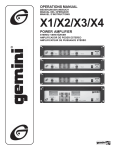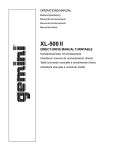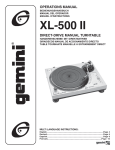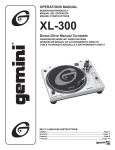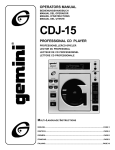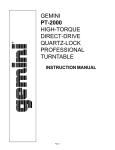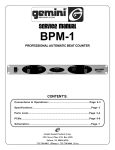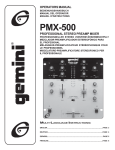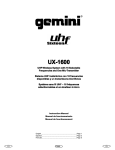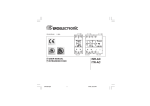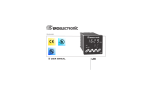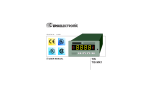Download Gemini XPM-3000 Stereo Amplifier User Manual
Transcript
OPERATIONS MANUAL BEDIENUNGSHANDBUCH MANUAL DEL OPERADOR MANUEL D’INSTRUCTIONS XPM-3000 POWER AMPLIFIER STEREO VERSTÄRKER AMPLIFICADOR DE PODER ESTEREO AMPLIFICATEUR DE PUISSANCE STÉRÉOV (1) 1 2 11 12 1 2 11 12 16 3 3 17 4 5 13 14 4 5 13 14 18 19 16 6 7 8 10 9 230V 15 6 8 7 10 9 120V 15 17 18 20 16 Gemini Sound Products Corp. 120 Clover Place, Edison, NJ 08818• USA Tel (732) 738-9003 • Fax (732) 738-9006 (2) 17 18 21 22 23 120V (3) 230V (4) Introduction Connections, Controls and Indicators Congratulations on purchasing a Gemini XPM-3000 Power Amplifier. This state of the art power amplifier includes the latest features and is backed by a five year limited warranty. Prior to use, we suggest that you carefully read all the instructions. Rear Panel Note: 120V and 230V units have different types of output connectors on the rear panel. Input Section: Features • • • • • • • • • • • • • • • • • • • • There are two parallel input connectors (one female XLR and one 1/4” jack) per channel. Either can be used as an input or as a link to chain amplifiers. MOSFET output stage technology for the finest sound quality and reliability 3 Channel Operation: 2 Satellite Channels (Channels A and B) and 1 Subwoofer Channel Full range operation mode for set up without subwoofer(s) 2-way Linkwitz-Riley crossover with switchable crossover frequency for flexible set up of subwoofer and satellite channels Switchable low frequency boost on the subwoofer channel optimizes subwoofer performance Stable operation of subwoofer channel down to a 2 Ohm load Post crossover line level outputs for chaining additional subwoofers and satellite speakers High output power to drive professional loudspeakers without clipping Oversized toroidal transformer, filter and heatsinks for better low end, transparency and stability Comprehensive protection circuitry (short, overheat, DC, subsonic and RF filters, turn-on delay) with high current speaker protection relays True clip LEDs for better control Signal ground lift switch eliminates hum from connection loops Flexible input configuration with active balanced inputs; additional input connectors to chain amps Outputs: 5-way binding posts in 120V; Neutrik Speakon connectors in 230V 2 parallel 5-way binding posts on the subwoofer output (in 120V only) allows for easy set up with dual subwoofers Efficient dual aluminum extrusion heatsink design for thermal stability and reliability Front-to-Rear airflow with 2 speed dual fan control Turn-on In-rush current limiting circuitry Compact 2U well balanced enclosure Steel reinforced chassis construction for durability and longevity XLR Input Jacks (11, 14): electronically balanced inputs accept a standard XLR male connector. Pin 1 = shield/ground, pin 2 = hot or positive (+) and pin 3 = cold or negative (-). 1/4" Input Jacks (12, 13): accept a balanced as well as an unbalanced line level signal. The unbalanced line uses a standard tip-sleeve connection. The tip is positive and the sleeve is negative/ground. The balanced line uses a tip-ring-sleeve connection. Tip = hot or positive (+), ring = cold or negative (-), and sleeve = shield/ground. Signal Ground Lift Switch (15) is used to lift the balanced input connectors’ ground/shield from the amplifier’s ground. When the signal ground is lifted, the sound source disconnects from the amplifier’s ground preventing ground loops which can generate hum and noise. See the Signal Ground Lift Switch Instructions for more detail. AC Power Section: Fuse (7): replace fuse with those of proper type and rating. AC Cord Outlet (6) is used to attach the power cord to the unit. Signal Processing Section: Disconnect the unit from the AC power source before making any connections. Crossover Switch (3): Use the crossover switch to set the crossover frequency between the subwoofer and the satellite channels (Channels A and B) at 120 Hz or 180 Hz. Or you can set the crossover switch to FULL RANGE if you do not wish to use a subwoofer (the full range signal will then go to the satellite channels). Low Frequency Boost Switch (4): The LF Boost Switch can be used to optimize the performance of the subwoofer. The LF boost effect uses specialized filter circuitry, including a subsonic filter, to cut off subsonic frequencies which keeps the subwoofer from wasting available energy. The filter also provides an optional +3 dB or +6 dB boost at 40 Hz which is suitable for most subwoofers. The circuitry optimizes the performance of the subwoofer by focusing the signal’s energy to match the subwoofer’s characteristics. Set the switch to be FLAT, +3 dB or +6 dB based on your subwoofer and your experience. Cautions Read all operating instructions before using this equipment. To reduce the risk of electrical shock, do not open the unit. There are NO USER REPLACEABLE PARTS INSIDE. Please contact the Gemini Service Department or your authorized dealer to speak to a qualified service technician. Be sure to allow adequate front and rear ventilation to avoid possible heat damage to your equipment. Be sure that AC power is OFF and all level controls are set to MINIMUM before making connections. This will eliminate any chance of unexpected, loud audio transients that could damage your speaker systems. NOTE: The LF Boost settings only effect the subwoofer channel and will not effect the satellite channels. Be sure that AC power is OFF when changing modes of operation and when changing the position of the ground lift switch. Line Outputs (1, 2, 5): the amplifier has quasi balanced post crossover line outputs. The line outputs connectors are 1/4” TRS and can be used to connect to additional amplifiers (optional). DO NOT EXPOSE THIS UNIT TO RAIN OR MOISTURE. Operators of electronic equipment should in no way be in contact with water. Output Section: Speaker Outputs: When connecting to AC power line be sure you haven’t lost the ground connection by using an adapter or extension cord without a 3 prong plug. Pay close attention to polarity (shown on the back of the unit) when connecting your speakers. Connecting your speaker systems using the wrong polarity will not damage your speakers, but it will impact the quality of the sound (lack of bass and incorrect stereo image). DO NOT USE ANY SPRAY CLEANER OR LUBRICANT ON ANY CONTROLS OR SWITCHES. Speaker Outputs for 120V Unit (8, 9, 10): the speaker output connectors are 5-way binding posts that will accept standard banana plugs, spade lugs or bare wire. Make sure that all the connections are clean when using bare wire connections. If any strands of wire from (5) Operating Instructions one connector touch the adjacent connector, the sound will be distorted, and your amplifier will overheat and go into protection mode. THE AMPLIFIER’S POWER MUST BE TURNED OFF WHEN CHANGING SETTINGS. NOTE (120V only): Two subwoofer output connectors are provided to connect two subwoofers with separate cables. These outputs are wired in parallel and are connected to a mono subwoofer channel (subwoofer output is not directional and does not require a stereo signal). The combined load for the subwoofer channel must not be less than 2 Ohms (a single 2 Ohm speaker OR two 4 Ohm speakers OR four 8 Ohm speakers). Using the Amplifier With Subwoofer(s) and Satellite Speakers The XPM-3000 has two channels for stereo operation and a common subwoofer channel. The amplifier has a built in crossover to separate the input signal between the stereo satellite channels and the mono subwoofer channel (the low frequency signal feeding the subwoofer is not directional and does not require stereo operation). The amplifier also provides an optional low frequency boost for the subwoofer channel to optimize the performance of your subwoofer. Speaker Outputs for 230V Unit (8, 9, 10): Neutrik Speakon connectors are provided to connect speakers to the amplifier quickly and easily. They are high current rated and provide very stable and durable contacts. Every Speakon connector has pin 1- as negative and pin 1+ as positive. WARNING: The XPM-3000 amplifier is designed to handle low impedance loads and will operate normally with most 2 Ohm subwoofers or subwoofer combinations. The amplifier will operate normally with most 4 Ohm speakers on the satellite channels. However, for optimal performance and reliability we recommend using subwoofers and speakers with higher impedance (4 Ohms for the subwoofer and 8 Ohms for the satellite channels). 1. With the power off, connect your input cables to the channel A and B inputs using either the XLR INPUT JACKS (11, 14) or 1/4" INPUT JACKS (12, 13) for each channel. The other channel A and channel B inputs can be used to link to an additional amplifier. 2. Connect the subwoofer(s) to the subwoofer SPEAKER OUTPUT(S) (10). Connect the full range loudspeakers to the channel A and channel B SPEAKER OUTPUTS (8, 9). THE TOTAL SPEAKER LOAD MUST BE AT LEAST 4 OHMS PER CHANNEL FOR THE SATELLITE CHANNELS AND 2 OHMS FOR THE SUBWOOFER. If you try to operate at a lower impedance, the amplifier will overheat and then go into protection mode and stop operation until you correct the load conditions. NOTE: There are no bridge connections in this amplifier. Please refer to the terminals’ color coding for proper connection polarity. Power (23): the power switch turns the unit on and off. 3. If you choose to use additional amplifiers, connect the additional amplifiers to the XPM-3000 using the LINE OUTPUT (1, 2, 5) connectors. Power LED (22): the power LED lights when the power is on. If the power LED does not light, refer to the trouble shooting guide. NOTE: The line outputs tap the signal after the crossover and the low frequency boost but before the level controls. Signal LED (16): the signal LEDs for each channel show when a signal is present. 4. Use the CROSSOVER SWITCH (3) to set the crossover frequency between the subwoofer and the satellite channels (Channels A and B) at 120 Hz or 180 Hz. Front Panel Clip LED (17): the amplifier has true clip LEDs to help you properly control the amplifier’s output and achieve undistorted sound. The clip LEDs for each channel light when your signal level is so strong that the distortion reaches 1% THD. The clip LED should not remain constantly on or flash repeatedly during operation. For clean sound reproduction, the clip should only light occasionally for an instant. If the LED remains on or flashes repeatedly, you will hear distorted sound that can be damaging to your speaker system. If this occurs, reduce the signal level by lowering the input level control for the channel that is clipping or reduce the level at the source. If the clip LED lights when no signal is present, it may indicate a RF signal on the output which may cause damage to speakers (the RF signal will not be audible). 5. Use the LOW FREQUENCY BOOST SWITCH (4) to optimize the performance of the subwoofer. The LF boost effect uses specialized filter circuitry, including a subsonic filter, to cut off subsonic frequencies which keeps the subwoofer from wasting available energy. The filter also provides an optional +3 dB or +6 dB boost at 40 Hz which is suitable for most subwoofers. Set the switch to be FLAT, +3 dB or +6 dB based on your subwoofer and your experience. NOTE: The LF Boost settings only effect the subwoofer channel and will not effect the satellite channels. 6. With the LEVEL CONTROLS (19, 20, 21) of the channels set to zero (fully counterclockwise), turn the POWER (23) on. Apply a signal to the input of the amplifier. The level of the input signal should be as high as you will ever need it to be. This way, it will be as high above the amplifier’s noise floor as possible, ensuring an excellent performance and signal to noise ratio. Adjust the LEVEL CONTROLS for each channel to achieve the desired maximum listening level. Note, when the clip LEDs light, there is distortion present in the amplifier’s output section. If a clip LED remains on or flashes repeatedly, reduce the signal level by lowering the input level control for the channel that is clipping or reduce the level at the source. Protect LED (18): when you first turn on the amplifier, the protect LEDs light briefly during a turn-on delay which indicates that the outputs are disconnected internally. There will be an audible click when the outputs reconnect and the protect LEDs will turn off. Otherwise, the protect LED indicates that there is a problem either in the amplifier’s external connections, load or temperature conditions or its internal functions. If one of these situations occur, the amplifier senses the problem and automatically switches into protection mode. The LED will light to warn you of the trouble and the amplifier will stop working. If this occurs, switch off the amplifier and refer to the Trouble Shooting Guide. If the protect LED remains lit when resuming amplifier operation, do not use the amplifier and contact an authorized service technician. Using the Amplifier Without Subwoofer(s) The XPM-3000 gives you the option of operating the amplifier as you would a conventional amplifier, without using subwoofer(s). This flexibility is especially useful if you don’t want to transport your subwoofers at times. Level Controls (19, 20, 21): establish the input levels required for each channel. 1. With the power off, connect your input cables to the channel A and B inputs using either the XLR INPUT JACKS (11, 14) or 1/4" INPUT JACKS (12, 13) for each channel. The other channel A and channel B inputs can be used to link to an additional amplifier. (6) 2. Connect the loudspeakers to the channel A and channel B SPEAKER OUTPUTS (8, 9). THE TOTAL SPEAKER LOAD MUST BE AT LEAST 4 OHMS PER CHANNEL FOR CHANNELS A AND B. If you try to operate at a lower impedance, the amplifier will overheat and then go into protection mode and stop operation until you correct the load conditions. Damping Factor: Channels A and B................................................................>300 @ 8 Ohms Subwoofer Channel.............................................................>600 @ 8 Ohms 3. If you choose to use additional amplifiers, connect the additional amplifiers to the XPM-3000 using the LINE OUTPUT (1, 2) connectors. Input Sensitivity: Channels A and B (for rated power at 8 Ohms)....................>300 @ 8 Ohms Subwoofer Channel (for rated power at 4 Ohms)...................>600 @ 8 Ohms 4. Set the CROSSOVER SWITCH (3) to FULL RANGE so that the full range signal will go to the satellite channels (Channels A and B). Input Impedance Unbalanced....................................................10 kOhms Slew Rate.................................................................................25 V/µS Voltage Gain.........................................................................................33 dB Input Impedance Balanced.......................................................20 kOhms 5. With the LEVEL CONTROLS (20, 21) of the channels set to zero (fully counterclockwise), turn the POWER (23) on. Apply a signal to the input of the amplifier. The level of the input signal should be as high as you will ever need it to be. This way, it will be as high above the amplifier’s noise floor as possible, ensuring an excellent performance and signal to noise ratio. Adjust the LEVEL CONTROLS for each channel to achieve the desired maximum listening level. Note, when the clip LEDs light, there is distortion present in the amplifier’s output section. If a clip LED remains on or flashes repeatedly, reduce the signal level by lowering the input level control for the channel that is clipping or reduce the level at the source. Power consumption.....................................................................1200 VA Note: power consumption is given at rated power at 8 Ohms per channel (Channels A and B), 4 Ohms on the subwoofer channel, all three channels driven. AC Power Requirement: (power connection is factory configured)............................120V/ 60 Hz 230V/ 50 Hz Indicators.......................................................................1 Power Indicator 1 Signal LED per channel 1 Clip LED per channel 1 Protect LED per channel Using the Signal Ground Lift Switch Depending on your system configuration, sometimes applying the ground will create a quieter signal path. Sometimes lifting the ground can eliminate ground loops and hum to create a quieter signal path. Cooling....................................2 Speed Dual Fan; Front-to-Rear Forced Air 1. With the power amp on, listen to the system in idle mode (no signal present) with the ground applied (the SIGNAL GROUND LIFT SWITCH (15) in the left position). Connectors: 2. Then turn the power off before moving the SIGNAL GROUND LIFT SWITCH (15). Lift the ground by moving the SIGNAL GROUND LIFT SWITCH to the right, turn the power back on and listen to determine which position will provide a signal devoid of background noise and hum. Keep the SIGNAL GROUND LIFT SWITCH in the ground position if the noise level remains the same in either position. Balanced Inputs..............................................................XLR Female Jack CAUTION: DO NOT TERMINATE THE AC GROUND ON THE POWER AMPLIFIER IN ANY WAY. TERMINATION OF THE AC GROUND CAN BE HAZARDOUS. Dimensions...................................19" x 13.75" x 3.5" (483 x 350 x 89 mm) Protection........................Short Circuit, DC, Thermal Cut-off, Sub/ultrasonic Frequency Filters, In-rush Current Limiter, Turn-on Delay Balanced/Unbalanced Inputs.......................................................1/4" Jack Line Outputs...............................................................................1/4" Jack Speaker Outputs (120V unit).......................................5-way binding posts 2 Parallel 5-way binding posts for subwoofers Speaker Outputs (230V unit)...........Speakons (ch.A, ch.B and subwoofer) Weight....................................................................................31 lbs (14 kg) * Specifications and design are subject to change without notice for purpose of improvement. Specifications Output Power EIA: 1kHz @ 1% THD (100 Hz @ 1% THD for the subwoofer channel) Subwoofers Ouput Power Chart: Impedance Not Used 8 Ohms 4 Ohms 2 Ohms 260 425 600 Not Used A and B Speakers 8 Ohms 220 4 Ohms 300 200 220 190 270 380 350 165 250 540 530 Note: the power for channels A and B is given as per channel, both channels driven Frequency Response - 3 Channel Operation: Channels A and B.......................................Crossover Frequency - 60 kHz Subwoofer Channel.....................................20 Hz - Crossover Frequency Frequency Response - Full Range Operation: Channels A and B.................................................................20 Hz - 60 kHz Crossover: Type.................................................................2nd order Linkwitz-Riley Crossover Frequency....................................................120 Hz/180 Hz Low Frequency Boost: Boost Frequency..............................................................................40 Hz Boost Level..............................................................................+3 dB/+6 dB Signal to Noise Ratio..........................100 dB below rated power, 8 Ohms (7) SYMPTOM UNIT DOES NOT PRODUCE SOUND. POWER LED DOES NOT LIGHT. CAUSE • POWER SWITCH NOT IN ON POSITION. • MOVE POWER SWITCH TO ON POSITION. • POWER CABLE NOT CONNECTED TO AMPLIFIER OR TO OUTLET. • CONNECT POWER CABLE TO AC SUPPLY. • AC OUTLET NOT ACTIVE. • REPLACE AMPLIFIER MAIN POWER FUSE ON REAR PANEL WITH CORRECT TYPE AND RATING. • MAIN AMPLIFIER FUSE DEFECTIVE. POWER LED LIGHTS, BUT NO SOUND IS PRODUCED BY AMPLIFIER. SOLUTION • NO INPUT SOURCE SIGNAL. • INPUT SOURCE NOT CONNECTED. • INPUT CONNECTING CABLE DEFECTIVE. • SPEAKER(S) NOT CONNECTED. • SPEAKER CABLE DEFECTIVE. • SPEAKER SYSTEM(S) INOPERATIVE. • CHECK CONDITION OF OUTLET. • CHECK FOR PROPER FUNCTION OF INPUT SOURCE DEVICE. • CHECK INPUT CABLES AND CONNECTIONS. REPLACE QUESTIONABLE CABLES WITH KNOWN GOOD CABLES. • CHECK SPEAKER CABLES AND CONNECTIONS. REPLACE QUESTIONABLE CABLES WITH KNOWN GOOD CABLES. • AMPLIFIER’S LEVEL CONTROLS ARE SET TO ZERO. • CHECK OPERATING CONDITION AND STATUS OF SPEAKER SYSTEM(S). BE SURE THE LEVEL CONTROLS ARE PROPERLY SET. SOUND IS PRESENT BUT VOLUME IS TOO LOW EVEN THOUGH SOURCE DEVICE IS SET TO A HIGH LEVEL. • AMPLIFIER INPUT LEVEL CONTROLS ARE SET TOO LOW. • ADJUST LEVEL CONTROLS AS PER INSTRUCTIONS. • WRONG PIN CONNECTIONS IN CABLES. • USE CORRECT CABLES (AS SHOWN ON BACK OF UNIT). VERY LITTLE OR NO OUTPUT FROM SUBWOOFER OR NO BASS FROM FULL RANGE SPEAKERS WHEN OPERATING WITHOUT SUBWOOFERS. • FREQUENCY SWITCH IS IN THE FULL RANGE MODE POSITION. • MOVE THE FREQUENCY SWITCH TO THE 120 HZ OR THE 180 HZ POSITION. LOUD 50/60 HZ OR 100/120 HZ HUM IS HEARD AT ALL TIMES THROUGH THE SPEAKER SYSTEMS. • IMPROPER OR DEFECTIVE GROUND CONNECTION AT INPUTS. IMPROPER OR DEFECTIVE GROUND AT INPUT SOURCE DEVICE(S). • CHECK FOR PROPER AC LINE GROUND ON POWER AMP AND ALL INPUT DEVICES. • IMPROPER OR DEFECTIVE GROUND CONNECTION ON AC OUTLET. SOUND IS DISTORTED. • CHECK INPUT CABLES FOR ALL SOURCE DEVICES AND SIGNAL PROCESSING AS WELL AS INPUT CABLES TO POWER AMPLIFIER. CHECK POSITION OF GROUND LIFT SWITCH AS PER INSTRUCTIONS FOR LIFTING THE GROUND. • GROUND LOOP THROUGH AC LINE CONNECTION/RACK MOUNTING. • NEVER LIFT THE AC LINE GROUND ON THE POWER AMPLIFIER. IF YOU ARE NOT TOTALLY FAMILIAR WITH GROUND LIFTING OR UNIFICATION PROCEDURES, DO NOT ATTEMPT THEM WITHOUT FIRST CONSULTING YOUR DEALER OR A QUALIFIED SOUND TECHNICIAN FOR MORE INFORMATION ON GROUNDING. IMPROPERLY DONE, SUCH PROCEDURES CAN POSE A SAFETY AND/OR FIRE HAZARD. • DISTORTION OCCURRING IN SOURCE DEVICE. • CHECK CLIP INDICATORS ON INPUT SOURCE DEVICES AND RESET LEVELS IF NECESSARY TO ELIMINATE DISTORTION. • INPUT LEVEL IS SET TOO HIGH. • ADJUST LEVEL CONTROLS AS PER INSTRUCTIONS. PROTECT LED REMAINS LIT OR GOES ON AND OFF INTERMITTENTLY AFTER USING AMPLIFIER FOR A SHORT TIME. • UNIT IS OPERATING AT EXCESSIVELY HIGH TEMPERATURE. • EXTREMELY LOW SPEAKER IMPEDANCE. • SHORT IN SPEAKER CONNECTORS, SPEAKER CABLE OR SPEAKER SYSTEM. • CHECK THAT AMPLIFIER IS ADEQUATELY VENTILATED ON THE FRONT AND REAR PANELS WHERE THE AIR VENTS AND FANS ARE LOCATED. IF OVERHEATED, LET THE AMPLIFIER COOL DOWN BEFORE APPLYING AN INPUT SIGNAL. • VERIFY SPEAKER SYSTEM IMPEDANCES. BE SURE THE TOTAL SPEAKER SYSTEM IMPEDANCE IS AT LEAST 4 OHM PER CHANNEL FOR CHANNELS A AND B, AND AT LEAST 2 OHM FOR THE SUBWOOFER CHANNEL. IF YOU ARE NOT SURE OF YOUR TOTAL SPEAKER IMPEDANCE LOAD, CONTACT YOUR DEALER FOR MORE INFORMATION. • CHECK CONDITION OF SPEAKER CABLES. • IF USING BARE WIRE CONNECTIONS ON THE OUTPUTS OF THE AMPLIFIER, BE SURE THAT NO STRANDS FROM ONE CONNECTOR ARE TOUCHING ANY OTHER CONNECTOR. FUSE BLOWS INTERMITTENTLY. • SPEAKER LOAD IMPEDANCE IS TOO LOW. • CHECK FOR SHORTS ON THE OUTPUTS. • TYPE OR RATING OF THE FUSE IS NOT CORRECT. • CHECK YOUR SPEAKER IMPEDANCE (INFO FROM DEALER). • CHECK THAT THE FUSE TYPE AND RATING IS CORRECT. PROTECT LED(S) STAY ON WITH NO SPEAKERS CONNECTED AND WITH THE AMPLIFIER COOLED DOWN. • FAILED AMPLIFIER. • CONTACT THE GEMINI SERVICE DEPARTMENT OR YOUR AUTHORIZED DEALER TO SPEAK TO A QUALIFIED SERVICE TECHNICIAN. IN THE U.S.A. CALL 1-732-969-9000 (8) In the USA: If you experience problems with this unit, call 1-732-738-9003 for Gemini Customer Service. Do not attempt to return this equipment to your dealer. Parts of the design of this product may be protected by worldwide patents. Information in this manual is subject to change without notice and does not represent a commitment on the part of the vendor. Gemini Sound Products Corp. shall not be liable for any loss or damage whatsoever arising from the use of information or any error contained in this manual. No part of this manual may be reproduced, stored in a retrieval system or transmitted, in any form or by any means, electronic, electrical, mechanical, optical, chemical, including photocopying and recording, for any purpose without the express written permission of Gemini Sound Products Corp. It is recommended that all maintenance and service on this product is performed by Gemini Sound Products Corp. or its authorized agents. Gemini Sound Products Corp. will not accept liability for loss or damage caused by maintenance or repair performed by unauthorized personnel. Worldwide Headquarters • 120 Clover Place, Edison, NJ 08837 • USA Tel: (732) 738-9003 • Fax: (732) 738-9006 France • G.S.L. France • 11, Avenue Leon Harmel, Z.I. Antony, 92160 Antony, France Tel: + 33 (0) 1 55 59 04 70 • Fax: + 33 (0) 1 55 59 04 80 Germany • Gemini Sound Products GmbH • Ottostrasse 6, 85757 Karlsfeld, Germany Tel: 08131 - 39171-0 • Fax: 08131 - 39171-9 UK • Gemini Sound Products • Unit C4 Hazleton Industrial Estate, Waterlooville, UK P08 9JU Tel: 087 087 00880 • Fax: 087 087 00990 Spain • Gemini Sound Products S.A. • Rosello, 516, Barcelona, Spain, 08026 Tel: 349-3435-0814 • Fax: 3493-347-6961 © Gemini Sound Products Corp. 2002 (28) All Rights Reserved









